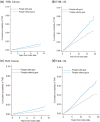Urate-lowering treatment and risk of total joint replacement in patients with gout
- PMID: 30060176
- PMCID: PMC6256332
- DOI: 10.1093/rheumatology/key212
Urate-lowering treatment and risk of total joint replacement in patients with gout
Abstract
Objectives: To examine whether gout is an independent risk factor for total joint replacement (TJR) and whether urate-lowering treatment (ULT) reduces this risk.
Methods: Using the Taiwan National Health Insurance database and the UK Clinical Practice Research Datalink, 74 560 Taiwan patients and 34 505 UK patients with incident gout were identified and age and sex matched to people without gout. Cox proportional hazards models and condition logistic regression were used to examine the risk of TJR in gout patients and the association between cumulative defined daily dose (cDDD) of ULT and TJR.
Results: The prevalence rates of TJR in the patients at the time of diagnosis of gout and in people without gout were 1.16% vs 0.82% in Taiwan and 2.61% vs 1.76% in the UK. After a gout diagnosis, the incidence of TJR was higher in the patients with gout compared with those without (3.23 vs 1.91 cases/1000 person-years in Taiwan and 6.87 vs 4.61 cases/1000 person-years in the UK), with adjusted HRs of 1.56 (95% CI 1.45, 1.68) in Taiwan and 1.14 (1.05, 1.22) in the UK. Compared with patients with gout with <28 cDDD ULT, the adjusted ORs for TJR were 0.89 (95% CI 0.77, 1.03) for 28-90 cDDD, 1.03 (0.85, 1.24) for 90-180 cDDD and 1.12 (0.94, 1.34) for >180 cDDD ULT in Taiwan. In the UK, the respective ORs were 1.09 (0.83, 1.42), 0.93 (0.68, 1.27) and 1.08 (0.94, 1.24).
Conclusion: This population-based study provides evidence from two nation populations that gout confers significant TJR risk, which was not reduced by current ULT.
Figures


References
-
- Wortmann R. Crystal-induced Arthropathies: Gout, Pseudogout, and Apatite-associated Syndromes. Boca Raton, FL: CRC Press, 2006.
-
- Abbott RD, Brand FN, Kannel WB, Castelli WP.. Gout and coronary heart disease: the Framingham Study. J Clin Epidemiol 1988;41:237–42. - PubMed
-
- Choi HK, Curhan G.. Independent impact of gout on mortality and risk for coronary heart disease. Circulation 2007;116:894–900. - PubMed
-
- Kuo CF, Yu KH, See LC. et al. Risk of myocardial infarction among patients with gout: a nationwide population-based study. Rheumatology 2013;52:111–7. - PubMed
Publication types
MeSH terms
Substances
LinkOut - more resources
Full Text Sources
Other Literature Sources
Medical

